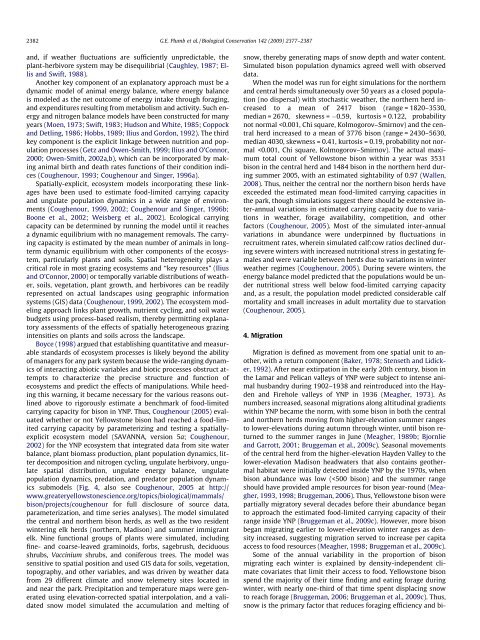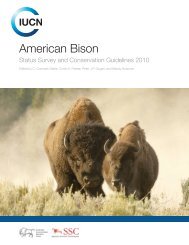Carrying capacity, migration, and dispersal in ... - ResearchGate
Carrying capacity, migration, and dispersal in ... - ResearchGate
Carrying capacity, migration, and dispersal in ... - ResearchGate
Create successful ePaper yourself
Turn your PDF publications into a flip-book with our unique Google optimized e-Paper software.
2382 G.E. Plumb et al. / Biological Conservation 142 (2009) 2377–2387<br />
<strong>and</strong>, if weather fluctuations are sufficiently unpredictable, the<br />
plant-herbivore system may be disequilibrial (Caughley, 1987; Ellis<br />
<strong>and</strong> Swift, 1988).<br />
Another key component of an explanatory approach must be a<br />
dynamic model of animal energy balance, where energy balance<br />
is modeled as the net outcome of energy <strong>in</strong>take through forag<strong>in</strong>g,<br />
<strong>and</strong> expenditures result<strong>in</strong>g from metabolism <strong>and</strong> activity. Such energy<br />
<strong>and</strong> nitrogen balance models have been constructed for many<br />
years (Moen, 1973; Swift, 1983; Hudson <strong>and</strong> White, 1985; Coppock<br />
<strong>and</strong> Detl<strong>in</strong>g, 1986; Hobbs, 1989; Ilius <strong>and</strong> Gordon, 1992). The third<br />
key component is the explicit l<strong>in</strong>kage between nutrition <strong>and</strong> population<br />
processes (Getz <strong>and</strong> Owen-Smith, 1999; Ilius <strong>and</strong> O’Connor,<br />
2000; Owen-Smith, 2002a,b), which can be <strong>in</strong>corporated by mak<strong>in</strong>g<br />
animal birth <strong>and</strong> death rates functions of their condition <strong>in</strong>dices<br />
(Coughenour, 1993; Coughenour <strong>and</strong> S<strong>in</strong>ger, 1996a).<br />
Spatially-explicit, ecosystem models <strong>in</strong>corporat<strong>in</strong>g these l<strong>in</strong>kages<br />
have been used to estimate food-limited carry<strong>in</strong>g <strong>capacity</strong><br />
<strong>and</strong> ungulate population dynamics <strong>in</strong> a wide range of environments<br />
(Coughenour, 1999, 2002; Coughenour <strong>and</strong> S<strong>in</strong>ger, 1996b;<br />
Boone et al., 2002; Weisberg et al., 2002). Ecological carry<strong>in</strong>g<br />
<strong>capacity</strong> can be determ<strong>in</strong>ed by runn<strong>in</strong>g the model until it reaches<br />
a dynamic equilibrium with no management removals. The carry<strong>in</strong>g<br />
<strong>capacity</strong> is estimated by the mean number of animals <strong>in</strong> longterm<br />
dynamic equilibrium with other components of the ecosystem,<br />
particularly plants <strong>and</strong> soils. Spatial heterogeneity plays a<br />
critical role <strong>in</strong> most graz<strong>in</strong>g ecosystems <strong>and</strong> ‘‘key resources” (Ilius<br />
<strong>and</strong> O’Connor, 2000) or temporally variable distributions of weather,<br />
soils, vegetation, plant growth, <strong>and</strong> herbivores can be readily<br />
represented on actual l<strong>and</strong>scapes us<strong>in</strong>g geographic <strong>in</strong>formation<br />
systems (GIS) data (Coughenour, 1999, 2002). The ecosystem model<strong>in</strong>g<br />
approach l<strong>in</strong>ks plant growth, nutrient cycl<strong>in</strong>g, <strong>and</strong> soil water<br />
budgets us<strong>in</strong>g process-based realism, thereby permitt<strong>in</strong>g explanatory<br />
assessments of the effects of spatially heterogeneous graz<strong>in</strong>g<br />
<strong>in</strong>tensities on plants <strong>and</strong> soils across the l<strong>and</strong>scape.<br />
Boyce (1998) argued that establish<strong>in</strong>g quantitative <strong>and</strong> measurable<br />
st<strong>and</strong>ards of ecosystem processes is likely beyond the ability<br />
of managers for any park system because the wide-rang<strong>in</strong>g dynamics<br />
of <strong>in</strong>teract<strong>in</strong>g abiotic variables <strong>and</strong> biotic processes obstruct attempts<br />
to characterize the precise structure <strong>and</strong> function of<br />
ecosystems <strong>and</strong> predict the effects of manipulations. While heed<strong>in</strong>g<br />
this warn<strong>in</strong>g, it became necessary for the various reasons outl<strong>in</strong>ed<br />
above to rigorously estimate a benchmark of food-limited<br />
carry<strong>in</strong>g <strong>capacity</strong> for bison <strong>in</strong> YNP. Thus, Coughenour (2005) evaluated<br />
whether or not Yellowstone bison had reached a food-limited<br />
carry<strong>in</strong>g <strong>capacity</strong> by parameteriz<strong>in</strong>g <strong>and</strong> test<strong>in</strong>g a spatiallyexplicit<br />
ecosystem model (SAVANNA, version 5a; Coughenour,<br />
2002) for the YNP ecosystem that <strong>in</strong>tegrated data from site water<br />
balance, plant biomass production, plant population dynamics, litter<br />
decomposition <strong>and</strong> nitrogen cycl<strong>in</strong>g, ungulate herbivory, ungulate<br />
spatial distribution, ungulate energy balance, ungulate<br />
population dynamics, predation, <strong>and</strong> predator population dynamics<br />
submodels (Fig. 4, also see Coughenour, 2005 at http://<br />
www.greateryellowstonescience.org/topics/biological/mammals/<br />
bison/projects/coughenour for full disclosure of source data,<br />
parameterization, <strong>and</strong> time series analyses). The model simulated<br />
the central <strong>and</strong> northern bison herds, as well as the two resident<br />
w<strong>in</strong>ter<strong>in</strong>g elk herds (northern, Madison) <strong>and</strong> summer immigrant<br />
elk. N<strong>in</strong>e functional groups of plants were simulated, <strong>in</strong>clud<strong>in</strong>g<br />
f<strong>in</strong>e- <strong>and</strong> coarse-leaved gram<strong>in</strong>oids, forbs, sagebrush, deciduous<br />
shrubs, Vacc<strong>in</strong>ium shrubs, <strong>and</strong> coniferous trees. The model was<br />
sensitive to spatial position <strong>and</strong> used GIS data for soils, vegetation,<br />
topography, <strong>and</strong> other variables, <strong>and</strong> was driven by weather data<br />
from 29 different climate <strong>and</strong> snow telemetry sites located <strong>in</strong><br />
<strong>and</strong> near the park. Precipitation <strong>and</strong> temperature maps were generated<br />
us<strong>in</strong>g elevation-corrected spatial <strong>in</strong>terpolation, <strong>and</strong> a validated<br />
snow model simulated the accumulation <strong>and</strong> melt<strong>in</strong>g of<br />
snow, thereby generat<strong>in</strong>g maps of snow depth <strong>and</strong> water content.<br />
Simulated bison population dynamics agreed well with observed<br />
data.<br />
When the model was run for eight simulations for the northern<br />
<strong>and</strong> central herds simultaneously over 50 years as a closed population<br />
(no <strong>dispersal</strong>) with stochastic weather, the northern herd <strong>in</strong>creased<br />
to a mean of 2417 bison (range = 1820–3530,<br />
median = 2670, skewness = 0.59, kurtosis = 0.122, probability<br />
not normal










